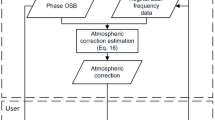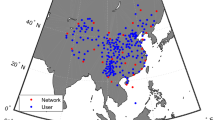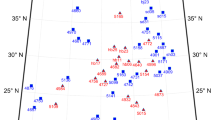Abstract
Integer ambiguity resolution-enabled precise point positioning (PPP), otherwise known as PPP real-time kinematic (PPP-RTK), recovers the integer nature of ambiguities at a user receiver by delivering the satellite phase biases (SPBs) estimated from a global navigation satellite system (GNSS) network. Due to the rank-deficiency existing between the satellite and receiver phase biases and the ambiguities, the formulation of PPP-RTK model needs to choose a set of unknown parameters as the datum (or the S-basis). Despite the fact that there are non-unique datum choices, one prefers a PPP-RTK model where the estimable SPBs contain a minimum number of datum ambiguities. We will show that otherwise there will be discontinuities occurring in datum ambiguities that will lead to unfavorable jumps in the estimated SPBs and frequent ambiguity resolution (re-)initialization on the user side. For this to occur one normally restricts to a common-view (CV) network, where the satellites are commonly visible to all receivers involved, and constructs the PPP-RTK model by choosing the phase biases and the ambiguities, pertaining to one receiver, as the datum. In doing so the CV model is capable of estimating the SPBs with each bias containing only one datum ambiguity. In this contribution we extend the CV model to an all-in-view (AV) network case where the satellites tracked can differ across receivers, but at least one satellite is commonly visible; this is practical as the network size is normally consisting of baseline lengths of several hundreds of kilometers. Contrary to the CV model, in the AV model the phase biases and the ambiguities pertaining to one satellite is selected as the datum, such that, the number of datum ambiguities entering into the estimable SPBs is always at the minimum as the SPBs are formulated in a between-satellite single-differenced form. The benefits with AV model are that it relieves the stringent satellite visibility as required by the CV model and, at the same time, reduces to the best possible extent any jumps in the estimated SPBs as well as the necessary ambiguity resolution (re-)initialization on the user side. Experiments conducted using multi-GNSS data collected in both CV and AV networks verify that the AV model always outperforms the CV one, as measured by both the time-to-first-fix as well as the positioning accuracy when compared to very precise benchmark coordinates.















Similar content being viewed by others
Data availability
The data used in this study are available from the corresponding author on reasonable request.
References
Baarda W (1973) S-transformations and criterion matrices. In: Publications on geodesy, 18, vol 5, no 1. Netherlands Geodetic Commission, Delft, The Netherlands
Banville S et al (2021) Enabling ambiguity resolution in CSRS-PPP. Navigation 68:433–451
Blewitt G (1990) An automatic editing algorithm for GPS data. Geophys Res Lett 17:199–202
Cai C, Liu Z, Xia P, Dai W (2013) cycle slip detection and repair for undifferenced GPS observations under high ionospheric activity. GPS Solut 17:247–260
de Lacy MC, Reguzzoni M, Sanso F (2012) Real-time cycle slip detection in triple-frequency GNSS. GPS Solut 16:353–362
Eueler HJ, Goad CC (1991) On optimal filtering of gps dual frequency observations without using orbit information. Bull Géod 65:130–143
Ge M, Gendt G, Rothacher M, Shi C, Liu J (2008) Resolution of GPS carrier-phase ambiguities in precise point positioning (PPP) with daily observations. J Geodesy 82:389–399
Grafarend E, Schaffrin B (1974) Unbiased free net adjustment. Surv Rev 22:200–218
Grafarend E, Schaffrin B (1976) Equivalence of estimable quantities and invariants in geodetic networks. Zeitschrift Vermessungswes 101:485–492
Henkel P, Psychas D, Günther C, Hugentobler U (2018) Estimation of satellite position, clock and phase bias corrections. J Geodesy 92:1199–1217
Hou P, Zhang B, Yasyukevich YV, Liu T, Zha J (2022) Multi-frequency phase-only PPP-RTK model applied to BeiDou data. GPS Solut 26:1–14
Khodabandeh A (2021) Single-station PPP-RTK: correction latency and ambiguity resolution performance. J Geodesy 95:1–24. https://doi.org/10.1007/s00190-021-01490-z
Khodabandeh A, Teunissen P (2015) An analytical study of PPP-RTK corrections: precision, correlation and user-impact. J Geodesy 89:1109–1132
Khodabandeh A, Teunissen PJG (2016) PPP-RTK and inter-system biases: the ISB look-up table as a means to support multi-system PPP-RTK. J Geodesy 90:837–851
Khodabandeh A, Teunissen PJG (2019) Integer estimability in GNSS networks. J Geodesy 93:1805–1819. https://doi.org/10.1007/s00190-019-01282-6
Koch K-R (1999) Parameter estimation and hypothesis testing in linear models. Springer, Berlin
Lannes A, Prieur J-L (2013) Calibration of the clock-phase biases of GNSS networks: the closure-ambiguity approach. J Geodesy 87:709–731
Leandro R, Santos M, Langley R (2006) UNB neutral atmosphere models: development and performance. In: Proceedings of the 2006 National Technical Meeting of the Institute of Navigation, pp 564–573
Li Z, Chen W, Ruan R, Liu X (2020) Evaluation of PPP-RTK based on BDS-3/BDS-2/GPS observations: a case study in Europe. GPS Solut 24:1–12
Lindlohr W, Wells D (1985) GPS design using undifferenced carrier beat phase observations. Manuscr Geodaet 10:255–295
Montenbruck O, Hauschild A, Steigenberger P, Hugentobler U, Teunissen P, Nakamura S (2013) Initial assessment of the COMPASS/BeiDou-2 regional navigation satellite system. GPS Solut 17:211–222
Naciri N, Bisnath S (2021) An uncombined triple-frequency user implementation of the decoupled clock model for PPP-AR. J Geodesy 95:60
Odijk D, Teunissen PJG, Zhang B (2012) Single-frequency integer ambiguity resolution enabled GPS precise point positioning. J Surv Eng 138:193–202
Odijk D, Zhang B, Khodabandeh A, Odolinski R, Teunissen PJG (2016) On the estimability of parameters in undifferenced, uncombined GNSS network and PPP-RTK user models by means of S-system theory. J Geodesy 90:15–44
Odijk D, Zhang B, Teunissen P (2015) Multi-GNSS PPP and PPP-RTK: some GPS+BDS results in Australia. In: Lecture notes in electrical engineering, vol 341, pp 613–623
Psychas D, Teunissen PJG, Verhagen S (2021) A multi-frequency Galileo PPP-RTK convergence analysis with an emphasis on the role of frequency spacing. Remote Sens 13:3077
Schönemann E, Becker M, Springer T (2011) A new approach for GNSS analysis in a multi-GNSS and multi-signal environment. J Geod Sci 1:204–214
Teunissen PJG (1985) Generalized inverses, adjustment, the datum problem and S-transformations. In: Grafarend EW, Sanso F (eds) Optimization of geodetic networks. Springer, Berlin
Teunissen PJG (1995) The least-squares ambiguity decorrelation adjustment: a method for fast GPS integer ambiguity estimation. J Geodesy 70:65–82
Teunissen PJG, Khodabandeh A (2015) Review and principles of PPP-RTK methods. J Geodesy 89:217–240
Teunissen P, Khodabandeh A (2021) A mean-squared-error condition for weighting ionospheric delays in GNSS baselines. J Geodesy 95:1–12
Teunissen PJG, Montenbruck O (2017) Springer handbook of global navigation satellite systems. Springer, Berlin
Teunissen P, De Jonge P, Tiberius C (1997) The Least-squares ambiguity decorrelation adjustment: its performance on short GPS baselines and short observation spans. J Geodesy 71:589–602
Teunissen PJG, Odijk D, Zhang B (2010) PPP-RTK: results of CORS network-based PPP with integer ambiguity resolution. J Aeronaut Astronaut Aviat Ser A 42:223–230
Verhagen S, Teunissen PJ (2013) The ratio test for future GNSS ambiguity resolution. GPS Solut 17:535–548
Wübbena G, Schmitz M, Bagge A (2005) PPP-RTK: precise point positioning using state-space representation in RTK networks. Paper presented at the proceedings on ION GNSS 2005, The Institute of Navigation, 13–16 Sept
Xu P (1995) Testing the hypotheses of non-estimable functions in free net adjustment models. Manuscr Geodaet 20:73–73
Xu P (1997) A general solution in geodetic nonlinear rank-defect models. Bollettino Di Geodesia e Scienze Affini 56:1–25
Yang Y, Gao W, Guo S, Mao Y, Yang Y (2019) Introduction to BeiDou-3 navigation satellite system. NAVIGATION J Inst Navig 66:7–18
Zangeneh-Nejad F, Amiri-Simkooei A, Sharifi M, Asgari J (2017) Cycle slip detection and repair of undifferenced single-frequency GPS carrier phase observations. GPS Solut 21:1593–1603
Zha J, Zhang B, Liu T, Hou P (2021) Ionosphere-weighted undifferenced and uncombined PPP-RTK: theoretical models and experimental results. GPS Solut 25:1–12
Zhang B, Teunissen PJ, Odijk D (2011) A novel un-differenced PPP-RTK concept. J Navig 64:S180–S191
Zhang B, Chen Y, Yuan Y (2019) PPP-RTK based on undifferenced and uncombined observations: theoretical and practical aspects. J Geodesy 93:1011–1024
Acknowledgements
This work was funded by the National Natural Science Foundation of China (Grant No. 42022025). The corresponding author is supported by the CAS Pioneer Hundred Talents Program.
Author information
Authors and Affiliations
Contributions
BZ proposed the method, designed the research, and wrote the manuscript. PH processed the data, analyzed the results, and wrote the manuscript. RO revised the manuscript.
Corresponding author
Appendix: Proof of Eqs. (18) and (19)
Appendix: Proof of Eqs. (18) and (19)
We consider a network where \(n\) receivers (\(r = 1, \ldots ,n\)) track \(m\) satellites (\(s = 1, \ldots ,m\)), and the receiver \(r\) tracks \(m_{r}\) satellites. Moreover, we assume that satellite 1 (\(s = 1\)) is commonly visible to all receivers. For brevity, we only consider the parameters on one frequency and omit the frequency index in the following. We write the vector of phase biases and ambiguities \({\overline{\mathbf{a}}}\) with its design matrix \({\overline{\mathbf{A}}}\) as
where \({\mathbf{B}} = \mathrm{blkdiag}\left( {\lambda {\mathbf{I}}_{{m_{1} }} ,\lambda {\mathbf{I}}_{{m_{2} }} , \ldots ,\lambda {\mathbf{I}}_{{m_{n} }} } \right)\), \({\mathbf{C}} = \mathrm{blkdiag}\left( {{\mathbf{e}}_{{m_{1} }} ,{\mathbf{e}}_{{m_{2} }} , \ldots ,{\mathbf{e}}_{{m_{n} }} } \right)\) and \({\mathbf{D}} = \left( { - {\mathbf{d}}_{{m_{1} \times m}}^{T} , - {\mathbf{d}}_{{m_{2} \times m}}^{T} , \ldots , - {\mathbf{d}}_{{m_{n} \times m}}^{T} } \right)^{T}\) in which \(\mathrm{blkdiag}\left( . \right)\) denotes a block diagonal matrix, \({\mathbf{I}}_{{m_{r} }}\) is an \(m_{r}\) identity matrix, \({\mathbf{e}}_{{m_{r} }}\) is a \(m_{r} \times 1\) vector of ones, and \({\mathbf{d}}_{{m_{r} \times m}}\) is the coefficient matrix of the satellite phase biases corresponding to the observations of receiver \(r\). \({\mathbf{Z}} = \left[ {{\mathbf{z}}_{1} ,{\mathbf{z}}_{2} , \ldots ,{\mathbf{z}}_{n} } \right]\) in which \({\mathbf{z}}_{r} = [z_{r}^{1} ,z_{r}^{2} , \ldots ,z_{r}^{{m_{r} }} ]\) is the ambiguity vector corresponding to receiver \(r\). \({{\varvec{\Delta}}}_{r} = \left[ {\overline{\delta }_{1} ,\overline{\delta }_{2} , \ldots ,\overline{\delta }_{n} } \right]\) and \({{\varvec{\Delta}}}^{{s}} = \left[ {\overline{\delta }^{1} ,\overline{\delta }^{2} , \ldots ,\overline{\delta }^{m} } \right]\) are the receiver phase biases and SPBs, respectively.
Since the column vectors of matrix \({\overline{\mathbf{A}}}\) is linearly dependent, the parameters of vector \({\overline{\mathbf{a}}}\) cannot be estimated unbiasedly. In what follows, we employ the S-system theory to identify and eliminate the rank deficiencies in a step-by-step manner. The linear dependence between the vector of receiver phase biases and SPBs is shown by
where \({\mathbf{c}}_{r}\) is the \(r_{th}\) column of \({\mathbf{C}}\) and \({\mathbf{d}}^{{s}}\) is the \(s_{th}\) column of \({\mathbf{D}}\). Equation (A2) indicates that one rank deficiency arises, for which we choose \(\overline{\delta }^{1}\) as the datum to eliminate. Hence, we delete \({\mathbf{d}}^{1}\) in \({\overline{\mathbf{A}}}\) and rewrite the design matrix and parameter vector as
where \({\hat{\mathbf{D}}} = \left[ {{\mathbf{d}}^{2} ,{\mathbf{d}}^{3} , \ldots ,{\mathbf{d}}^{m} } \right]\), \({\hat{\varvec{\Delta }}}_{r} = \left[ {\hat{\hat{\delta }}_{1} ,\hat{\hat{\delta }}_{2} , \ldots ,\hat{\hat{\delta }}_{n} } \right]\), and \({\hat{\varvec{\Delta }}}^{{s}} = \left[ {\hat{\hat{\delta }}^{2} ,\hat{\hat{\delta }}^{3} , \ldots ,\hat{\hat{\delta }}^{m} } \right]\), in which
are the redefined receiver phase bias and SPB.
The linear dependence between-receiver phase biases and ambiguities is indicated by
where \({\mathbf{b}}_{{r_{k} }}\) is the \(k_{th}\) column vector of \({\mathbf{B}}_{r}\) and \({\mathbf{B}}_{r}\) denotes the coefficient matrix of the ambiguities corresponding to receiver \(r\), i.e., \(\left[ {{\mathbf{B}}_{1} ,{\mathbf{B}}_{2} , \ldots ,{\mathbf{B}}_{n} } \right] = {\mathbf{B}}\). To eliminate this rank deficiency of size \(n\), we choose \(z_{r = 1, \ldots ,n}^{1}\) as the datum, which is guaranteed by the fact that all receivers track satellite 1. Hence, we delete the first column vector of \({\mathbf{B}}_{r = 1, \ldots ,n}\) and obtain
where \({\hat{\mathbf{B}}} = \left[ {{\hat{\mathbf{B}}}_{1} ,{\hat{\mathbf{B}}}_{2} , \ldots ,{\hat{\mathbf{B}}}_{n} } \right]^{T}\), \({\hat{\mathbf{Z}}} = \left[ {\hat{z}_{1} ,\hat{z}_{2} , \ldots ,\hat{z}_{n} } \right]\), and \({{\tilde{\tilde{\varvec{\Delta }}}}}_{r} = \left[ {\tilde{\tilde{\delta }}_{1} ,\tilde{\tilde{\delta }}_{2} , \ldots ,\tilde{\tilde{\delta }}_{n} } \right]\) in which
where \(\tilde{\tilde{\delta }}_{r}\) is the estimable receiver phase bias and is the same as that in Eq. (19).
Finally, the rank deficiency originating from SPBs and ambiguities is identified by
in which the \({\mathbf{b}}_{{k_{s} }}\) is the column vector of \({\hat{\mathbf{B}}}_{k}\) corresponding to satellite \(s\). To eliminate these \(m - 1\) rank deficiencies, we choose a pivot receiver, denoted as receiver \(x\left( s \right)\), for each satellite and choose the corresponding ambiguities \(z_{x\left( s \right)}^{{s}}\) (\(s > 1\)) as the datum, yielding estimable parameters as
which are identical to the estimable SPBs and ambiguities in Eq. (19).
We remark that although the choice of ambiguity datum is not unique when addressing the rank deficiency between-receiver phase biases and ambiguities as shown by Eq. (A5), only the choice of \(z_{r = 1, \ldots ,n}^{1}\) makes Eq. (A8) satisfied for arbitrary AV cases. Otherwise, Eq. (A8) may involve the column vector corresponding to the receiver phase biases, resulting in the estimable SPBs that may contain many ambiguities. This is the reason why the AV model requires at least one CV satellite.
Rights and permissions
Springer Nature or its licensor (e.g. a society or other partner) holds exclusive rights to this article under a publishing agreement with the author(s) or other rightsholder(s); author self-archiving of the accepted manuscript version of this article is solely governed by the terms of such publishing agreement and applicable law.
About this article
Cite this article
Zhang, B., Hou, P. & Odolinski, R. PPP-RTK: from common-view to all-in-view GNSS networks. J Geod 96, 102 (2022). https://doi.org/10.1007/s00190-022-01693-y
Received:
Accepted:
Published:
DOI: https://doi.org/10.1007/s00190-022-01693-y




